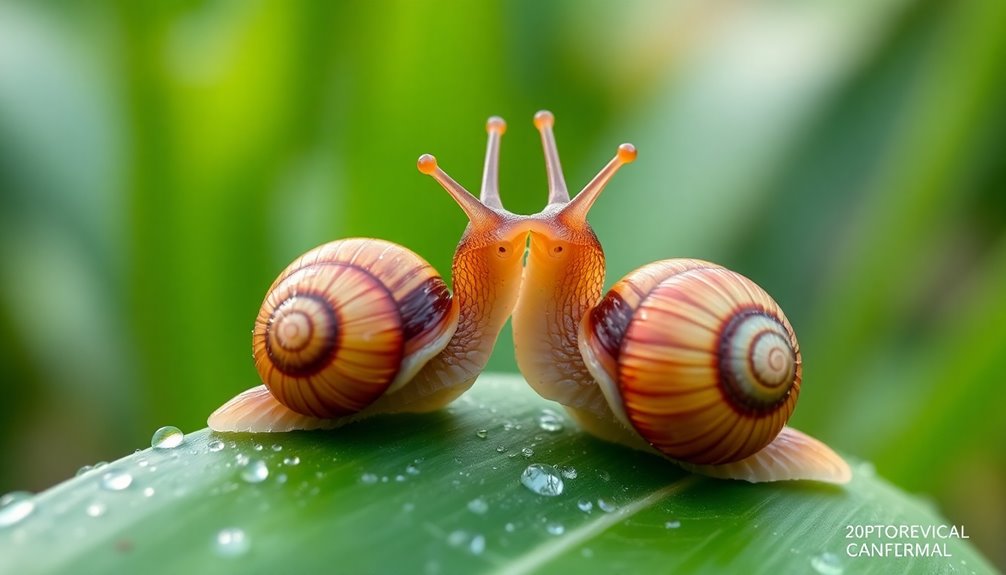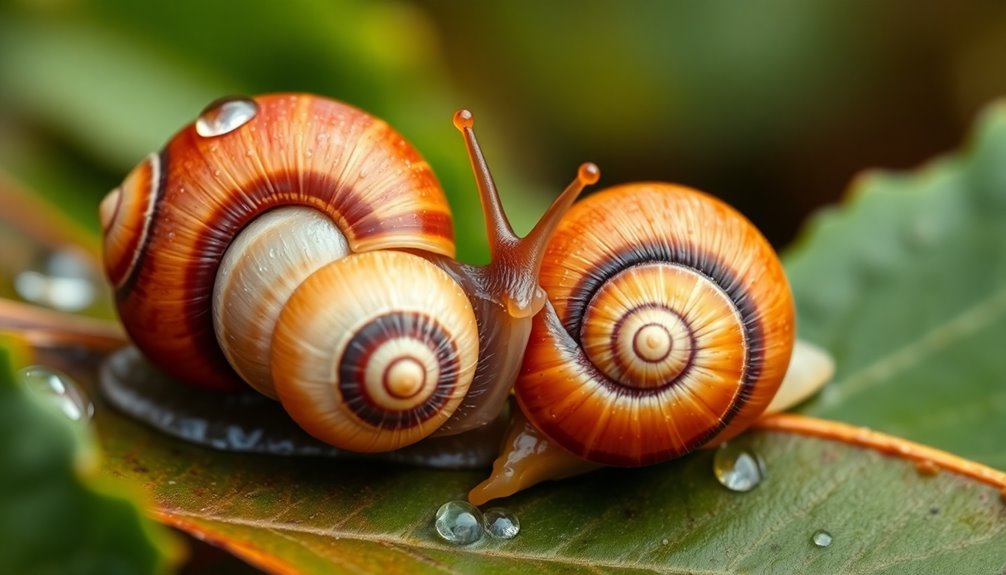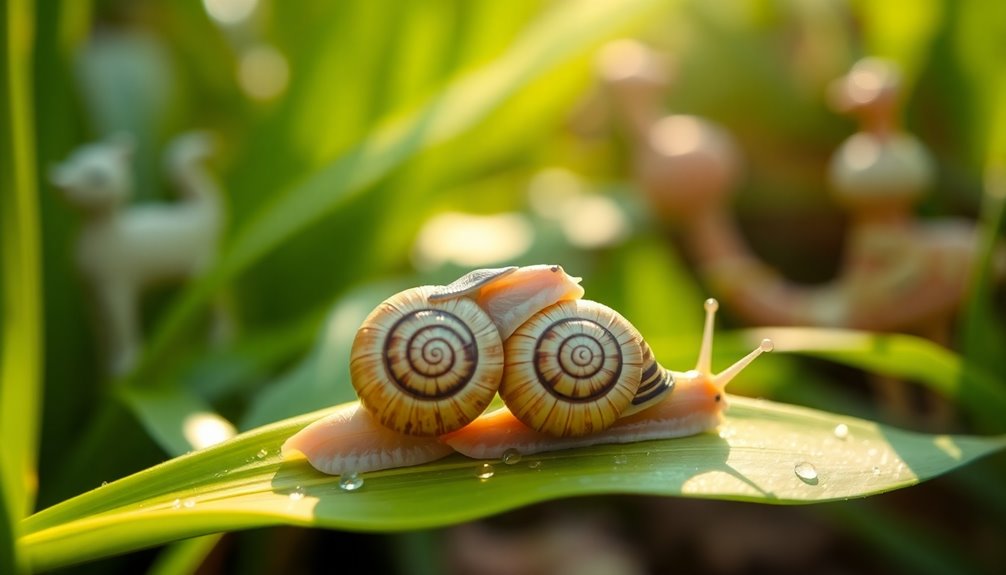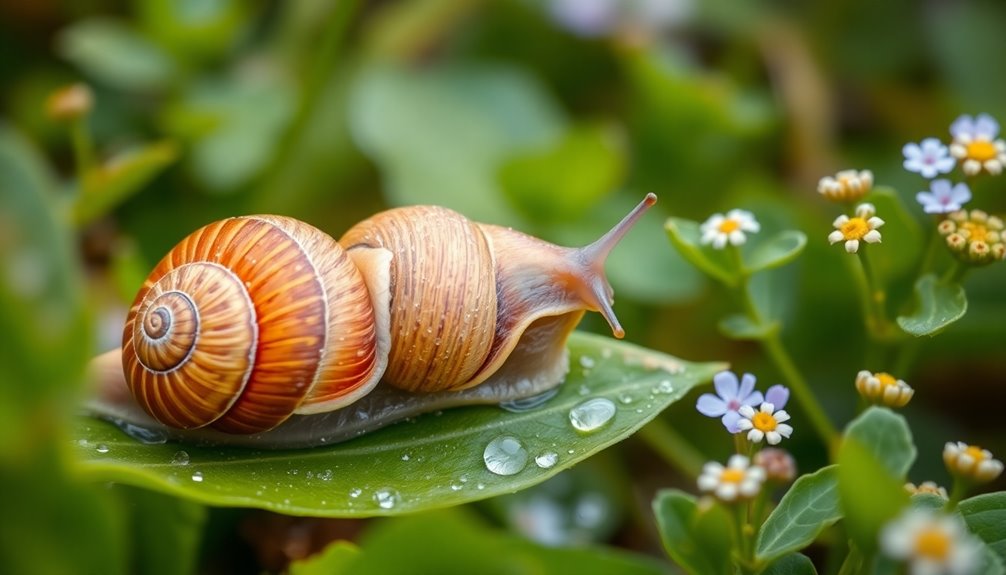When a snail falls in love, you'll find a mix of cute behaviors and biological wonders at play. Snails are hermaphroditic, meaning they can mate with any other snail they encounter, giving them flexibility in their romantic escapades. Their courtship involves enchanting dances and the exchange of pheromones, which signal readiness and attraction. Some snails even use "love darts" to enhance their chances of mating success. These rituals showcase their unique take on romance. Fascinating, right? Stick around to uncover even more adorable aspects of snail love and the science behind it!
Key Takeaways
- Snails engage in elaborate mating rituals involving dances and pheromone exchanges to attract partners and establish territories.
- Their hermaphroditic nature allows snails to mate with any encountered partner, enhancing reproductive flexibility.
- Communication includes body language, such as tentacle touching and circling, which strengthens social bonds during courtship.
- "Love darts" are used by some species to deliver hormones, increasing the chances of successful reproduction.
- After mating, female snails lay eggs in moist environments, ensuring the safety and survival of their offspring.
The Biology of Snails

When you think about snails, you might picture their soft bodies and coiled shells, which are defining traits of the class Gastropoda.
These fascinating creatures have a unique biology that sets them apart. Snails are hermaphrodites, meaning they possess both male and female reproductive organs, allowing them to mate with any other snail they encounter.
Their diet consists mainly of plant material, which they scrape off surfaces using a specialized tongue called a radula. This robust radula helps them efficiently feed.
As they move, snails secrete mucus, enabling them to glide smoothly across various surfaces. This mucus not only aids in locomotion but also provides a protective barrier against predators and harsh environmental conditions, ensuring their survival.
Understanding Snail Behavior

When you observe snails, you'll notice their fascinating communication methods, like the use of pheromones to signal potential mates.
Their mating rituals, including the intriguing "love darts," reveal much about their reproductive strategies.
Plus, various environmental factors can influence their activity levels, shaping how and when they interact.
Snail Communication Methods
Though often overlooked, snail communication methods reveal a complex world of behavior that's fascinating to explore. Snails primarily rely on pheromones, chemical signals that attract mates and establish territory.
When you observe them, you might notice a male extending his tentacles, a clear sign of readiness to communicate. Their body language plays a crucial role in courtship, as they engage in intricate movements like circling and tentacle touching to convey interest and compatibility.
Some species even exhibit copulatory courtship, performing elaborate rituals that deepen their bond before mating. This multifaceted approach to communication showcases how snails express themselves beyond simple instinct, highlighting their unique social interactions in the animal kingdom.
Mating Rituals and Behaviors
Mating rituals among snails showcase their intricate behaviors and remarkable adaptability. As hermaphrodites, snails can mate with any compatible partner they encounter.
During courtship, they engage in an elaborate dance that lasts several hours, exchanging pheromones to attract one another. This careful alignment guarantees successful copulation.
Some species take it a step further by using "love darts," where they shoot a calcified spike into their partner, delivering hormones that enhance reproductive success.
After this intimate encounter, female snails lay clusters of eggs in safe, moist environments, with the number of eggs varying by species.
This fascinating process highlights the unique and intricate world of snail romance, guaranteeing the continuation of their species through careful mating rituals.
Environmental Influences on Activity
Although snails are often seen as slow-moving creatures, their activity levels are heavily influenced by environmental factors.
Humidity plays an essential role, as these little mollusks thrive in moist conditions that help prevent desiccation and enable smooth movement.
You'll notice they're most active when temperatures range from 15°C to 25°C (59°F to 77°F).
Notably, snails prefer nighttime activity to avoid predators and conserve moisture.
The presence of food sources, especially decaying plant matter, can prompt them to explore and forage enthusiastically.
Additionally, snails rely on chemical cues in their environment to detect food and mates, showcasing a heightened sense of smell that helps them navigate their surroundings effectively.
Understanding these influences reveals the complexity of their behavior.
The Chemistry of Love

When you experience love, your brain undergoes a fascinating chemical transformation. Neurotransmitters like dopamine flood your system, creating feelings of euphoria and desire. This rush activates your brain's reward system, similar to the effects of addictive substances, making love feel exhilarating.
As you share physical touch—like hugging or holding hands—your oxytocin levels rise, fostering attachment and deepening your bond. You might even feel "butterflies in your stomach" as adrenaline kicks in, heightening your emotional responses and physical sensations.
Research shows that couples in love often display synchronized brain activity, indicating a shared emotional experience that strengthens their connection. Love isn't just a feeling; it's a complex dance of chemistry and emotions that keeps you drawn to each other.
Courtship Rituals in Snails

As you observe the enchanting world of snails, you'll notice that their courtship rituals are anything but simple.
These fascinating creatures engage in elaborate dances and release pheromones to attract their mates. When two snails find each other, they intertwine their bodies, often exchanging sperm for several hours.
Some species, like the common garden snail, are hermaphroditic, allowing them to mate with any compatible partner. A unique aspect of their courtship involves "love darts," which snails shoot at one another to boost reproductive success.
After this intricate mating process, female snails lay clusters of eggs in moist soil or vegetation, ensuring their offspring thrive in a suitable environment.
Snail love truly is an adorable spectacle of nature!
Evolutionary Significance of Love

The intricate courtship rituals of snails highlight a fascinating aspect of love that extends beyond mere attraction.
Love plays an essential role in pair bonding, enhancing the chances of successful reproduction and cooperative parenting. When snails engage in affectionate interactions, they release oxytocin, the "love hormone," which fosters trust and strengthens social bonds.
This emotional attachment is critical for raising offspring together, as it promotes a supportive environment. Studies suggest that strong romantic feelings lead to increased commitment and lower infidelity, ensuring genetic continuity.
Additionally, love-related behaviors influence mate selection, with individuals often preferring partners who exhibit signs of genetic fitness, such as health and compatibility.
Therefore, love's evolutionary significance is deeply intertwined with survival and reproductive success.
Snails in Popular Culture

You might notice how snails pop up in literature and art, often symbolizing slowness and patience.
Their presence in stories and visuals reflects deeper themes of introspection and gradual progress.
From classic fables to contemporary films, snails offer a unique lens through which we explore love and relationships.
Snails in Literature
Although often overlooked, snails have carved out a significant niche in literature and popular culture, symbolizing traits like patience and resilience.
In Aesop's fable "The Tortoise and the Hare," the slow but steady character triumphs, teaching us the value of perseverance.
In children's literature, Julia Donaldson's "Snail and the Whale" showcases the themes of friendship and adventure, highlighting the joy of exploration despite limitations.
Additionally, the term "snail mail" reflects cultural attitudes toward communication, contrasting the slow pace of physical letters with today's instant messaging.
Snails inspire artistic expression too, serving as symbols of tranquility and introspection.
Through various narratives, snails remind us that slow and steady can lead to meaningful connections and achievements.
Symbolism of Slowness
Snails embody a profound symbolism of slowness in popular culture, reflecting a deliberate approach to life that contrasts sharply with today's fast-paced world.
Their steady pace encourages introspection and character development, reminding you that meaningful outcomes often require patience.
- The tortoise's victory in "The Tortoise and the Hare" illustrates that slow and steady can win the race.
- Snails evoke vulnerability, highlighting the need for protection and care in our narratives.
- The charm of "snail mail" brings nostalgia for thoughtful communication.
- Their slow movement invites contemplation, fostering personal growth.
Snails in Art
Throughout history, artists have drawn inspiration from snails, using their unique qualities to convey themes of patience and perseverance.
You'll find snails in art, from the surreal works of Salvador Dalí to the vibrant paintings of Henri Matisse. Their whimsical nature often reflects the slow, deliberate movement of life, serving as a reminder to take things at your own pace.
In popular culture, snails appear in children's literature and animated films like "
Frequently Asked Questions
What Is the Story of When a Snail Falls in Love?
When a snail falls in love, it experiences a unique blend of emotions and instincts.
You can imagine the delicate dance of courtship, where two snails inch closer, exchanging pheromones to signal their affection.
As they touch, they engage in a slow, tender embrace, bonding over their shared journey.
In this enchanting moment, you witness nature's beauty, reminding you that love can be a gentle, gradual process, even in the most unexpected forms.
Is When a Snail Falls in Love Worth Watching?
If you're considering whether "When a Snail Falls in Love" is worth watching, you'll likely find it engaging.
With strong performances and undeniable chemistry between the leads, it draws you in. The plot's twists keep you guessing while balancing crime-solving and romance seamlessly.
High production quality, including stunning visuals, enhances your viewing experience.
How Many Episodes Are in When a Snail Falls in Love?
There are a total of 21 episodes in "When a Snail Falls in Love." Each episode runs for about 30 minutes, making it perfect for binge-watching.
You'll find that the series cleverly combines crime and romance, keeping you engaged throughout.
As you watch, you'll enjoy the gradual development of both the plot and the characters, which adds depth to the viewing experience.
It's a compact series that's definitely worth your time!
When as Neil Fall in Love Cast?
You'll find the cast of "When a Snail Falls in Love" features talented actors like Wang Zi Wen as Xu Xu, who brings depth to her character, and Wang Kai as Ji Bai, who balances strength and compassion.
Supporting roles include Yao Meng, known for her sharp observations, and Zhao Han, a respected peer of Ji Bai.
The chemistry between Wang Zi Wen and Wang Kai really stands out, enhancing the show's appeal.
Conclusion
As you immerse yourself in the enchanting world of snails, you discover that love isn't just a human affair. These little creatures, with their delicate shells and gentle movements, paint a vivid picture of romance in nature. From their unique courtship dances to the chemistry that sparks their affection, snails remind us that love can bloom in the most unexpected places. So next time you see a snail, remember: even the slowest hearts can race when it comes to love.








